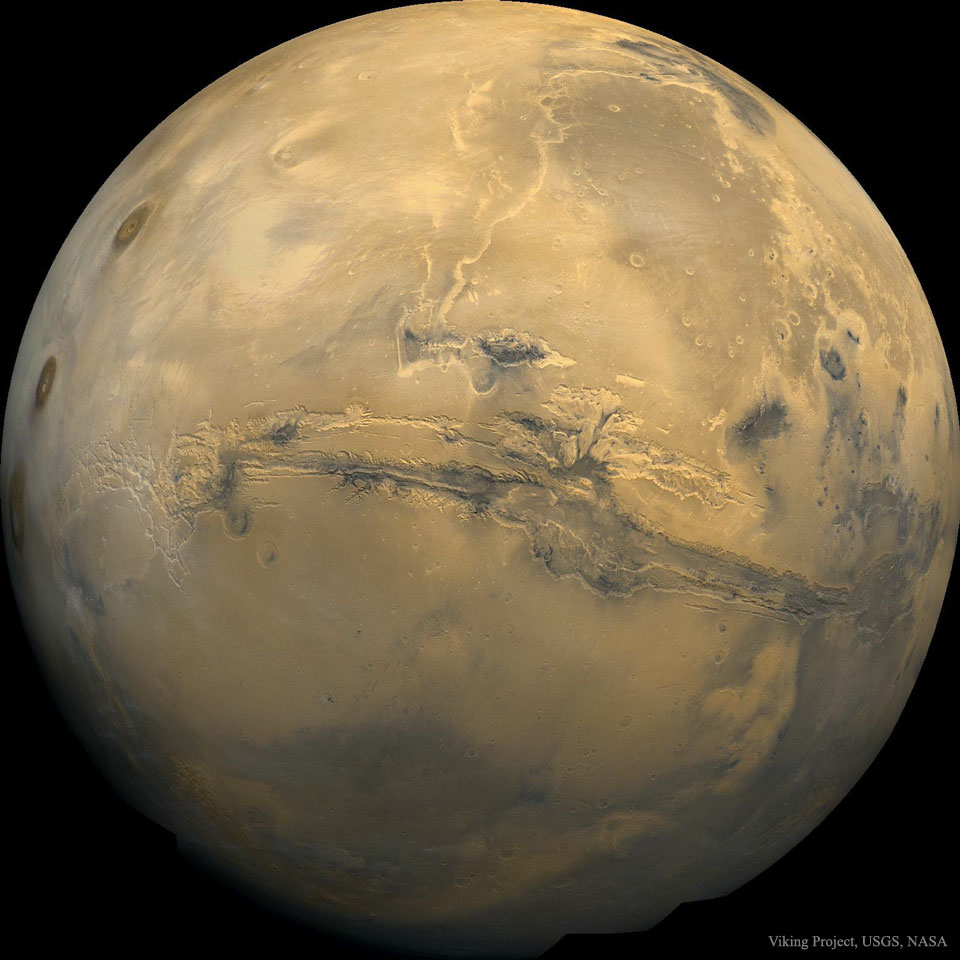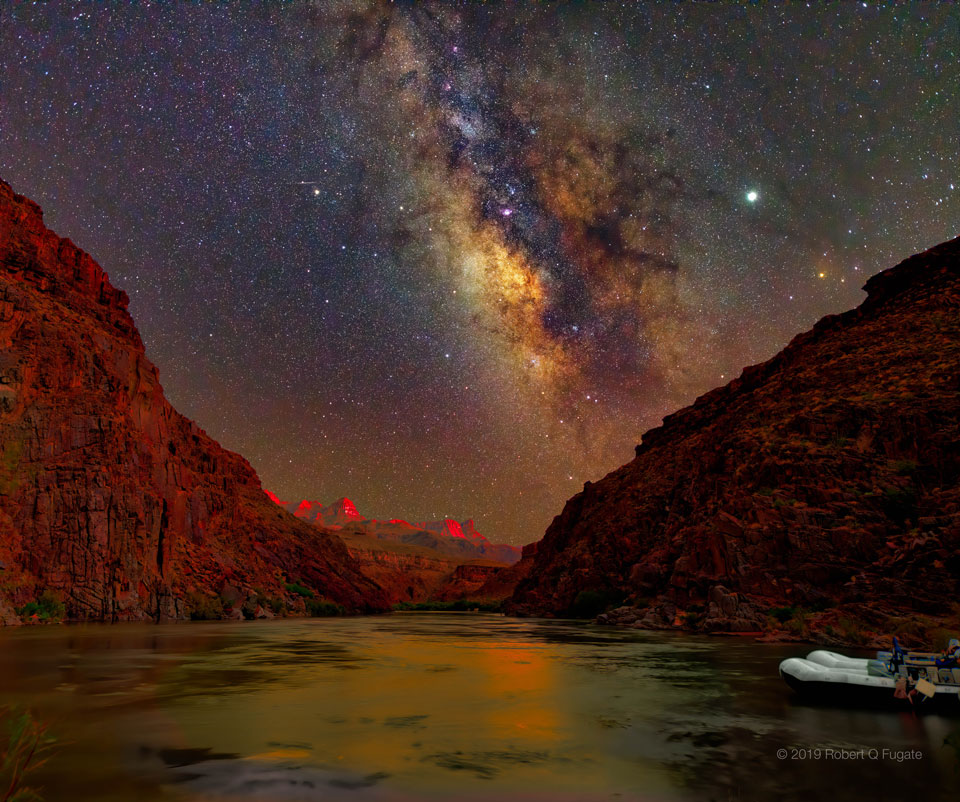

Astronomy Picture of the Day for 2020-05-24 12:30:01.740998
Astronomy Picture of the Day (Unofficial) at 2020-05-24T17:30:02Z
Discover the cosmos! Each day a different image or photograph of our fascinating universe is featured, along with a brief explanation written by a professional astronomer.
Valles Marineris: The Grand Canyon of Mars
Image Credit: NASA, USGS, Viking ProjectExplanation: The largest canyon in the Solar System cuts a wide swath across the face of Mars. Named Valles Marineris, the grand valley extends over 3,000 kilometers long, spans as much as 600 kilometers across, and delves as much as 8 kilometers deep. By comparison, the Earth's Grand Canyon in Arizona, USA is 800 kilometers long, 30 kilometers across, and 1.8 kilometers deep. The origin of the Valles Marineris remains unknown, although a leading hypothesis holds that it started as a crack billions of years ago as the planet cooled. Several geologic processes have been identified in the canyon. The featured mosaic was created from over 100 images of Mars taken by Viking Orbiters in the 1970s.
Tomorrow's picture: interstellar monster José Antonio Seguido Doblado, Jackson de Jesus, nukem likes this.
nukem shared this.

Astronomy Picture of the Day for 2020-05-25 12:30:02.183949
Astronomy Picture of the Day (Unofficial) at 2020-05-25T17:30:02Z
Discover the cosmos! Each day a different image or photograph of our fascinating universe is featured, along with a brief explanation written by a professional astronomer.
Mystic Mountain Monster being Destroyed
Image Credit: Hubble, NASA, ESA; Processing & License: Judy SchmidtExplanation: Inside the head of this interstellar monster is a star that is slowly destroying it. The huge monster, actually an inanimate series of pillars of gas and dust, measures light years in length. The in-head star is not itself visible through the opaque interstellar dust but is bursting out partly by ejecting opposing beams of energetic particles called Herbig-Haro jets. Located about 7,500 light years away in the Carina Nebula and known informally as Mystic Mountain, the appearance of these pillars is dominated by dark dust even though they are composed mostly of clear hydrogen gas. The featured image was taken with the Hubble Space Telescope. All over these pillars, the energetic light and winds from massive newly formed stars are evaporating and dispersing the dusty stellar nurseries in which they formed. Within a few million years, the head of this giant, as well as most of its body, will have been completely evaporated by internal and surrounding stars.
APOD across world languages: Arabic, Catalan, Chinese (Beijing), Chinese (Taiwan), Croatian, Czech, Dutch, Farsi, French,
French, German, Hebrew, Indonesian, Japanese, Korean, Montenegrin, Polish, Russian, Serbian, Slovenian, Spanish and Ukrainian
Tomorrow's picture: Higher than the HimalayasJosé Antonio Seguido Doblado, nukem likes this.

Astronomy Picture of the Day for 2020-02-04 12:30:01.982368
Astronomy Picture of the Day (Unofficial) at 2020-02-04T18:30:02Z
Discover the cosmos! Each day a different image or photograph of our fascinating universe is featured, along with a brief explanation written by a professional astronomer.
A Sunset Night Sky over the Grand Canyon
Image Credit & Copyright: Robert Q. FugateExplanation: Seeing mountain peaks glow red from inside the Grand Canyon was one of the most incredible sunset experiences of this amateur photographer's life. They appeared even more incredible later, when digitally combined with an exposure of the night sky -- taken by the same camera and from the same location -- an hour later. The two images were taken last August from the 220 Mile Canyon campsite on the Colorado River, Colorado, USA. The peaks glow red because they were lit by an usually red sunset. Later, high above, the band of the Milky Way Galaxy angled dramatically down, filled with stars, nebula, and dark clouds of dust. To the Milky Way's left is the planet Saturn, while to the right is the brighter Jupiter. Although Jupiter and Saturn are now hard to see, Venus will be visible and quite bright to the west in clear skies, just after sunset, for the next two months.
Astrophotography with Your Computer: NASA's Astrophoto Challenges
Tomorrow's picture: many moonMcClane, Michele Montagna, José Antonio Seguido Doblado likes this.
McClane shared this.

Dianara 1.4.3 is out

It's finally time for another minor release of Dianara, my desktop application for Pump.io.
The two main changes are the addition of a character picker (including emojis, of course) and spell checking. Both features use KDE Frameworks components, and are optional at compile-time.
https://jancoding.wordpress.com/2019/12/28/dianara-v1-4-3-is-out/
Cheers! 😃
José Antonio Seguido Doblado, nukem, Panko, RiveraValdez and 4 others likes this.
Panko, JanKusanagi @identi.ca, Stephen Michael Kellat, McClane and 2 others shared this.

JanKusanagi at 2019-02-02T21:14:59Z
Pero si nada impide usar la misma cuenta en ambos xD
José Antonio Seguido Doblado likes this.


